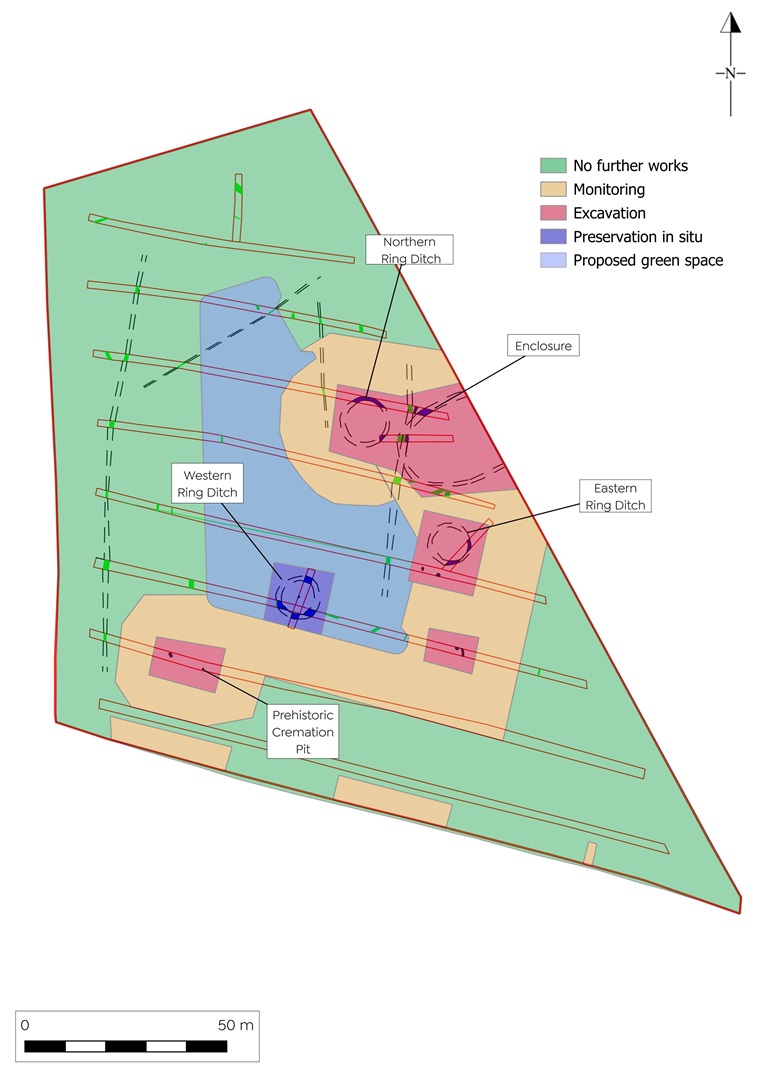2023:559 - Milltown, Ashbourne, Meath
County: Meath
Site name: Milltown, Ashbourne
Sites and Monuments Record No.: N/A
Licence number: 23E0437
Author: Steven McGlade
Author/Organisation Address: Archaeology Plan, 32 Fitzwilliam Place, Dublin 2
Site type: Ring-ditches
Period/Dating: Prehistoric (12700 BC-AD 400)
ITM: E 707010m, N 751050m
Latitude, Longitude (decimal degrees): 53.498554, -6.387112
An archaeological test-trenching programme was undertaken on a site in Milltown townland to the south of Ashbourne, Co. Meath in May 2023. A geophysical survey of the site had was completed by Joanna Leigh in April 2023 (23R0159), which identified a number of anomalies including two probable ring-ditches and a portion of an enclosure or a larger ring-ditch. Numerous ring-ditches were identified during testing of a site to the east (Licence No. 22E0590, Excavations Ref. 2022:179), while other ring-ditches and enclosures have been identified in the field to the east of the site.
The subsequent testing programme confirmed that the two circular anomalies were ring-ditches and that the remains of an enclosure survived to the east. A third ring-ditch was also identified along with a cremation pit to the south and several additional features. The features were clustered in the central and eastern part of the field. A central cremation pit was identified within one of the ring-ditches, which also had an extended inhumation burial within its enclosing ditch along the northern arc.
The three ring-ditches were identified within the field on a low rise overlooking the townland and parish boundary at the southern end of the site. The three ring-ditches ranged from 8-10m in internal diameter. The western example was the deepest at over 0.55m, with the other two being very shallow suggesting the site has been heavily scarped. The eastern and western ring-ditches appear to be related to burial. The northern example also contained unburnt animal bone and was adjacent to the enclosure. It is unconfirmed at present whether this feature represents a structure or a burial monument.
The ploughed-out remains of a larger enclosure were also uncovered at Milltown. Animal bone was recorded within the fill of the enclosure ditch, which was shallow and heavily scarped. No features were identified in the interior during the testing programme. The eastern portion of the enclosure has been truncated by the Dublin Road, which was constructed in the late 18th century. The enclosure may represent the remains of a larger ring-ditch burial monument or be the remains of a small settlement enclosure. The enclosure is approximately 20m in diameter internally, which would be small for an early medieval settlement enclosure or ringfort. A similarly sized enclosure excavated at Clonard or Folkstown Great, Co. Dublin (Licence No. 15E0586, Excavations Ref. 2016:150) was radiocarbon dated to the Middle Bronze Age and remained in use into the Iron Age, while a slightly smaller example associated with a structure was excavated near Kildare town, Co. Kildare (Licence No. 21E0261, Excavations Ref. 2021:468) and was dated to the Iron Age.
A small cremation pit was uncovered to the south of the western ring-ditch indicating the burial area extends in this direction and that additional features may also be present.
The testing indicated that previously the ground level would have been higher at the eastern end of the field, with this area being scarped and reduced, presumably through agricultural activity. The larger enclosure and two of the ring ditches were located on this previously raised ground and were found to have been heavily truncated with only the base of the features surviving.
There was no indication of a date for the enclosure at Milltown, and as such it may date to a broad period of prehistory, or the early historic period. The ring-ditches are also undated at present. Two of the examples identified to the west at Baltrasna in 2022 were also associated with extended inhumations, one of which also contained metalworking slag, suggesting an Iron Age date. It is possible the burials are later inserts into pre-existing burial monuments, with a number of these previously excavated in the Dublin and Meath area dating to the transitional period around the time of the introduction of Christianity to Ireland. It is equally possible the ring-ditches are late in then sequence of these monuments, dating to the Late Iron Age.
Based on the results of the archaeological assessment a number of recommendations were made including monitoring, excavation, and preservation in situ.

